2025 demands sharper content marketing benchmarks grounded in real performance data and business outcomes. You need clear content marketing metrics, your KPIs, to evaluate engagement, traffic sources, and overall ROI. Tracking these metrics lets you measure returns, improve SEO visibility, align with goals, and spot growth opportunities.
Data-driven decisions ensure resources deliver measurable, strategic gains across teams. Across channels, you’ll quantify lead generation, audience retention, evergreen performance, backlinks, and mobile responsiveness for ranking. Begin with search visibility fundamentals and Monitor Organic Traffic Growth Patterns to benchmark momentum, content relevance, and compounding ROI.
Monitor Organic Traffic Growth Patterns
Monitoring organic traffic growth patterns clarifies whether your SEO is compounding amid seasonality. Organic search traffic means visitors arriving via unpaid results on Google or Bing, without ad costs. Track sessions, users, and landing pages in Google Analytics 4 for trendlines.
Use Google Search Console to connect queries, clicks, impressions, and average position. Compare week-over-week, month-over-month, and rolling 90-day averages to smooth volatility from algorithm updates. Segment by device, geography, and content type to isolate meaningful growth drivers.
Set targets aligned to business goals, then optimize pages showing consistent upward momentum, and annotate major releases.
Track Lead Generation Conversion Rates
Lead generation conversion rate is a make-or-break benchmark in 2025. When you track it rigorously, you expose funnel friction and revenue opportunities.
- Decide whether your conversion means form submission, demo request, or qualified lead. Use clear formulas: conversion rate equals conversions divided by visits, expressed as %. Across industries, typical website visitor-to-lead rates sit between 1%-3%.
- Benchmark by offer type to catch where intent translates into action. Gated content landing pages often convert 15%-30%, while webinar registrations hit 20%-40%. High-intent demo request pages usually convert 2%-6% of sessions, but pipeline value spikes.
- Follow your funnel: Lead to MQL, MQL to SQL, and SQL to won. Healthy 2025 benchmarks:
- Lead-to-MQL 10%-30%
- MQL-to-SQL 20%-40%
- SQL-to-closed 20%-30%Tracking each stage prevents vanity gains that never convert into revenue.
- Instrument micro-steps in your forms: start rate, field completion, and error rate. Aim to lift landing-page conversion 10%-20% per quarter through tested changes. Use A/B tests with 95% confidence and 500+ visits per variant.
Measure Engagement on Social Channels
Engagement is the heartbeat of social performance, not vanity noise. With 5.41 billion users active worldwide (65.7%), you need channel‑specific benchmarks.
- Calculate engagement rate per impression, not per follower, for truer signal. Use likes, comments, shares, saves, and clicks divided by impressions, times 100.
- Maintain channel‑level benchmarks because behavior and baselines differ by network and audience. Typical users juggle 6.84 platforms monthly, so compare engagement patterns platform by platform. Smaller creators see about 7.5% engagement on TikTok versus 3.65% on Instagram.
- Measure time‑to‑engage curves within the first hour, day, and week. Global users spend 141 minutes daily; the Philippines averages 218 minutes, the United States 129. Use those windows to judge whether your posts earned timely, sustained interaction.
- Segment engagement by content type and funding to see what actually drives action. Organic remains widely used by 73% of businesses, with just over half adding paid. Since 58% discover new businesses on social, prioritize comments, shares, saves, and profile taps.
Assess Influencer Collaboration Outcomes
Influencer collaborations are powerful, but outcomes require disciplined benchmarking. You should tie creator efforts to clear business results, not vanity signals.
- Prioritize platforms where B2B value is consistently proven. Eighty-five percent say LinkedIn delivers the best value, signaling stronger collaboration potential. Since 84% already invest in paid channels but only 16% use influencers, which you can exploit a gap.
- Define outcome metrics before contracting, and map attribution to each creator. Track creator-tagged opportunity opens, pipeline velocity changes, and revenue influenced via UTMs or codes. Benchmark results against your top paid channel, with 61% naming SEM/PPC best.
- Measure content reuse yield to prove value beyond the initial post. Count placements secured, UGC assets licensed, and paid units built from creator material. With 73% buying social ads, creator content can fuel those units efficiently.
- Protect performance with strict briefs, FTC disclosures, and brand safety checks. More than 53% still struggle to measure content impact, with 6% far behind. You improve outcomes by requiring on-time delivery, accurate tagging, and pre-post lift studies.
Evaluate Backlink Quality and Quantity
After evaluating partnership results, refocus on backlinks, the compounding asset behind sustainable rankings. You should benchmark quantity by unique referring domains, not raw link totals. You also need quality thresholds: topical relevance, authoritative pages, natural anchors, and 60–80% dofollow.
Backlink scarcity is real, 94% of blog posts earn zero external links (Backlinko). To raise linkability, publish assets that attract coverage; videos can lift traffic 70% (Semrush). With 45% using AI for research and 45% for drafts, rigorous editing safeguards originality (Content Marketing Institute).
As budgets rise for 38% of CMOs, allocate resources to digital PR, outreach, and quarterly link-growth targets for 2025.
Analyze Branded Search Volume Trends
Branded search volume reveals demand shifts and brand health you can quantify.
- Mobile and voice weighting: Segment branded query trends by device type and surface voice-led spikes explicitly. With 63% preferring mobile search, expect outsized brand demand there (HubSpot, 2024). Voice usage hit 20.5%, yet only 13% optimize for it (HubSpot, 2024).
- Campaign correlation window: Align branded query peaks with campaign launches across email, video, and Instagram activity. Email converts at 2.8% for B2C and 2.4% for B2B (FirstPageSage, 2025). Short-form video dominates, and Instagram reaches 2 billion monthly users worldwide (Backlinko, 2025).
- Seasonality and content cadence: Build weekly and yearly baselines to separate genuine brand momentum from predictable seasonality. Longer posts average 1,400 words, reflecting heavier content pushes that affect discovery (Orbit Media, 2024). With 54% using AI for ideas, cadence spikes may distort trendlines temporarily (Orbit Media, 2024).
Review Content Reach Across Platforms
Reviewing content reach across platforms helps you, whether B2B manager, startup founder, or small business owner. Compare how blogs, videos, infographics, and interactive pieces find audiences across channels. Recent shifts show video and interactive media taking center stage for reach.
These formats captivate audiences, delivering stronger recall and often higher conversion rates. Use AI-driven personalization to adapt distribution by audience preference and device behavior. With budget allocation becoming essential, you should prioritize channels showing consistent cross-platform reach.
For 2025 benchmarking, document reach by format and platform to inform smarter SEO gains.
Examine Referral Source Effectiveness Regularly
Referral sources can quietly drive or drain performance across your funnel and sales conversations. Given 66% struggle to track journeys and 63% to attribute ROI, disciplined reviews protect budget and focus.
- Attribution discipline: Standardize attribution for referrals using consistent UTM governance and rules everyone understands. Only 48% measure performance effectively, while 63% struggle to attribute ROI reliably.
- Quality-weighted scorecards: Weight each source by contribution to goals aligned with organizational objectives (70% prioritize this), not vanity clicks. Start quarterly scorecards that blend cost, assisted impact, and sales feedback for prioritization.
- Data readiness and cadence: Fix data silos and reporting gaps that block timely referral analysis and action. With 55% citing silos, 40% inadequate tools, and 52% alignment gaps, run monthly joint reviews with sales and marketing.
Benchmark Share of Voice Against Competitors
Benchmarking share of voice against competitors helps you gauge real visibility within your category. Calculate SOV by dividing your brand metrics by total market metrics, then multiplying by 100. For example, 200 mentions out of 2,000 total industry mentions equals 10% social SOV.
Target 25-30% SOV for strong presence, because anything below 10% indicates inadequate visibility. According to Nielsen, brands with higher SOV than share of market usually grow, while underperformers shrink.
In less-mature markets, organic SOV predicts outcomes better, while mature markets emphasize paid SOV.
Gauge Audience Retention with Analytics Tools
Strong retention signals prove your content’s value beyond clicks. You don’t need complexity, just analytics that clarify what to measure and improve.
- Average engagement time and engaged sessions per user: Track average engagement time and engaged sessions per user in Google Analytics across content hubs. Flag pages where engagement time falls 20% below your site median for focused optimization. Ensure the metric is actionable, pointing to clear next steps and outcomes.
- Cohort retention and returning user ratio: Use cohort analysis to compare 7-day and 28-day return rates by topic or format. Prioritize content where cohorts retain at least 10% higher than your established baseline. Consolidate retention data with other metrics across 80+ channels to contextualize performance trends.
- Scroll depth, completion, and falloff mapping: Measure median scroll depth and content completion to locate friction points within long-form experiences. Set alerts when scroll depth drops sharply, then investigate layout, readability, and intent alignment issues. Content marketing compounding takes time, so track improvements longitudinally rather than expecting instant ROI.
Quantify Evergreen Content Performance Metrics
Building on those retention learnings, you now need to quantify the workhorses: evergreen content. A well-crafted how-to keeps earning visits for years; it’s an asset, not a gamble. Define an Evergreen Longevity Score: the % of your evergreen URLs within +/-10% sessions for 12 months.
Calculate Half-Life to Value: days until a page accrues 50% of lifetime sessions, which is looking like it’s favoring 365+ days.
Measure Refresh Lift by page: % change in 90-day sessions after updates; resilient pieces often deliver 15–40%. Track SERP Tenure too: average weeks in the top 10 for target terms and featured snippet wins.
For 2025 benchmarks, you should expect evergreen to drive 60–80% steady, year-round discovery that compounds credibility.
Optimize Mobile Responsiveness for Ranking
Prioritize mobile responsiveness because search performance increasingly depends on mobile experience. Mobile now drives around 60% of global web traffic, according to Statista. Google confirms mobile-first indexing is complete, so mobile rendering governs crawling and ranking.
Aim for Core Web Vitals targets: LCP under 2.5 seconds, INP under 200 ms, CLS under 0.1 (Google). Google reports bounce probability jumps 32% when load time slips from one to three seconds. Use responsive images, AVIF/WebP compression, and a CDN; AVIF can reduce file sizes 20–30% (Google web.dev).
Ensure readable fonts, accessible contrast, and 44 px touch targets (Apple), then iterate with Lighthouse, PageSpeed Insights, and CrUX.
Staying focused on the right benchmarks keeps your 2025 strategy accountable, agile, and aligned with revenue outcomes and profit. Track content assisted pipeline, conversion rate by segment, cost per acquisition, retention, and contribution to sales velocity by channel. You should benchmark organic visibility, dwell time, email CTR, MQL to SQL velocity, and ROI by content format.
Double down on what compounds, sunset underperformers faster, and communicate impact using shared definitions with sales. When you measure consistently, you make smarter bets, protect budgets, and earn trust across finance, product, and leadership.








